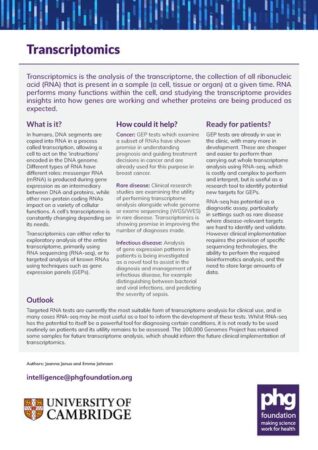Transcriptomics is the analysis of the transcriptome, the collection of all ribonucleic acid (RNA) that is present in a sample (a cell, tissue or organ) at a given time. RNA performs many functions within the cell, and studying the transcriptome provides insights into how genes are working and whether proteins are being produced as expected.
What is it?
In humans, DNA segments are copied into RNA in a process called transcription, allowing a cell to act on the ‘instructions’ encoded in the DNA genome. Different types of RNA have different roles: messenger RNA (mRNA) is produced during gene expression as an intermediary between DNA and proteins, while other non-protein coding RNAs impact on a variety of cellular functions. A cell’s transcriptome is constantly changing depending on its needs.
Transcriptomics can either refer to exploratory analysis of the entire transcriptome, primarily using RNA sequencing (RNA-seq), or to targeted analysis of known RNAs using techniques such as gene expression panels (GEPs).
How could it help?
Cancer: GEP tests which examine a subset of RNAs have shown promise in understanding prognosis and guiding treatment decisions in cancer and are already used for this purpose in breast cancer.
Rare disease: Clinical research studies are examining the utility of performing transcriptome analysis alongside whole genome or exome sequencing (WGS/WES) in rare disease. Transcriptomics is showing promise in improving the number of diagnoses made.
Infectious disease: Analysis of gene expression patterns in patients is being investigated as a novel tool to assist in the diagnosis and management of infectious disease, for example distinguishing between bacterial and viral infections, and predicting the severity of sepsis.
Ready for patients?
GEP tests are already in use in the clinic, with many more in development. These are cheaper and easier to perform than carrying out whole transcriptome analysis using RNA-seq, which is costly and complex to perform and interpret, but is useful as a research tool to identify potential new targets for GEPs.
RNA-seq has potential as a diagnostic assay, particularly in settings such as rare disease where disease-relevant targets are hard to identify and validate. However clinical implementation requires the provision of specific sequencing technologies, the ability to perform the required bioinformatics analysis, and the need to store large amounts of data.
Outlook
Targeted RNA tests are currently the most suitable form of transcriptome analysis for clinical use, and in many cases RNA-seq may be most useful as a tool to inform the development of these tests. Whilst RNA-seq has the potential to itself be a powerful tool for diagnosing certain conditions, it is not ready to be used routinely on patients and its utility remains to be assessed. The 100,000 Genomes Project has retained some samples for future transcriptome analysis, which should inform the future clinical implementation of transcriptomics.

